Posted by Elena del Valle on July 30, 2020

The Body A Guide for Occupants
Photo: Doubleday
In The Body A Guide for Occupants (Doubleday, $30) Bill Bryson, an American writer (born in Des Moines, Iowa) living in England, explores the human body. The 450-page hardcover book was published in 2019. Using some lesser known and unexpected tidbits he entertains readers with a curious and light exploration of some aspects of the human body, dispensing with gory descriptions. Often his discussion includes history and historic figures or quotes from authors, researchers and academics.
For example, in the chapter on Nerves and Pain he quotes Patrick Wall as a leading British neuroscientist and author of Pain: The Science of Suffering; and Oliver Sacks, who in a book on migraines described almost one hundred types of migraines. In The Outside: Skin and Hair chapter he quotes Peter Stark in Last Breath: Cautionary Tales from the Limits of Human Endurance, saying that a man who weighs 155 pounds has about 42 quarts of water in his body; and he will lose one and a half quarts of water a day via urination, sweat and respiration.
The hardcover book is divided into 23 chapters: How to Build a Human; The Outside: Skin and Hair; Microbial You; The Brain; The Head; Down the Hatch: The Mouth and Throat; The Heart and Blood; The Chemistry Department; In the Dissecting Room: The Skeleton; On the Move: Bipedalism and Exercise; Equilibrium; The Immune System; Deep Breath: The Lungs and Breathing; Food, Glorious Food; The Guts; Sleep; Into the Nether Regions; In the Beginning: Conception and Birth; Nerves and Pain; When Things Go Wrong: Diseases; When Things Go Very Wrong: Cancer; Medicine Good and Bad; and The End.
Bryson is author of 19 other books, including A Walk in the Woods, The Life and Times of the Thunderbolt Kid, and A Short History of Nearly Everything. He was chancellor of Durham University, England’s third oldest university, from 2005 to 2011, and is an honorary fellow of Britain’s Royal Society.
According to his FaceBook page he met his wife in England, where they settled; he wrote for The Times and The Independent before moving back to the United States with his wife and four children. He and his family moved back to England in 2003.
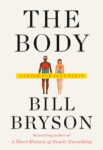
Click to buy The Body: A Guide for Occupants
Posted by Elena del Valle on July 20, 2020
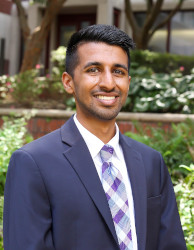
Zuhair Haleem, Ph.D. student, University of Florida
A podcast interview with Zuhair Haleem, Ph.D. student, University of Florida, is available in the Podcast Section of Hispanic Marketing and Public Relations, HispanicMPR.com. During the podcast, he discusses a 2020 University of Florida DEET study with Elena del Valle, host of the HispanicMPR.com podcast.
Zuhair works in the Department of Health Services Research, Management & Policy in the College of Public Health at the University of Florida. Zuhair holds a master’s degree in health administration from Virginia Commonwealth University (VCU). Prior to joining the University of Florida he spent two years as a process improvement specialist for the Inova Health System in the DC suburbs of Virginia. Zuhair has also worked for VCU Health’s Office of Health Innovation as well as the Virginia Health Care Foundation, two Richmond based organizations that support Virginia’s health care safety net through population health management strategies. Zuhair’s research interests are in the areas of health policy and health economics, specifically addressing disparities in health outcomes.
To listen to the interview, scroll down until you see “Podcast” on the right hand side, then select “HMPR Zuhair Haleem” and click on the play button below or download the MP3 file to your iPod or MP3 player to listen on the go, in your car or at home from the RSS feed. Some software will not allow flash, which may be necessary for the play button and podcast player. If that is your case, you will need to download the file to play it. To download it, click on the arrow of the recording you wish to copy and save it to disk. The podcast will remain listed in the July 2020 section of the podcast archive.
Posted by Elena del Valle on July 6, 2020
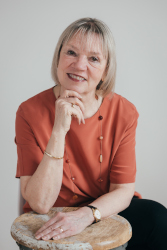
Susan J. Douglas, author, In Our Prime
Photo: H. Nash
A podcast interview with Author Susan J. Douglas is available in the Podcast Section of Hispanic Marketing and Public Relations, HispanicMPR.com. We will discuss her new book In Our Prime: How Older Women are Reinventing the Road Ahead (W.W. Norton and Company, $25.95).
Susan is the Catherine Neafie Kellogg Professor and Arthur F. Thurnau professor of Communication and Media at The University of Michigan. In Our Prime was recommended as an “Editors’ Choice/Staff Picks” by The New York Times and hailed by the Associated Press as a “masterful takedown of gendered ageism.” She is author of Celebrity: A History of Fame, The Rise of Enlightened Sexism: How Pop Culture Took us from Girl Power to Girls Gone Wild; The Mommy Myth: The Idealization of Motherhood and How it Undermines Women with Meredith Michaels; Listening In: Radio and the American Imagination, which won the Hacker Prize in 2000 for the best popular book about technology and culture; Where The Girls Are: Growing Up Female with the Mass Media; and Inventing American Broadcasting, 1899-1922.
To listen to the interview, scroll down and click on the play button below or locate the “Podcast” section on the right hand side, then choose “HMPR Susan J. Douglas” or download the MP3 file to your iPod or MP3 player to listen on the go, in your car or at home from the RSS feed. Some software will not allow flash, which may be necessary for the podcast player. If that is your case, you will need to download the file to play it. To download it, click on the arrow of the recording you wish to copy and save it to disk. The podcast will remain listed in the July 2020 section of the podcast archive.
Click to buy In Our Prime
Posted by Elena del Valle on June 22, 2020

Marleny Gomez, realtor, HomeSmart
Photo: HomeSmart Elite Group
A podcast interview with Marleny Gomez, realtor, HomeSmart, during which she shares her thoughts about real estate in Arizona post pandemic is available in the Podcast Section of Hispanic Marketing and Public Relations, HispanicMPR.com.
According to her bio Marleny, a United States Marine Corps veteran, is on a mission to help families build and grow their wealth through home ownership. She has a background in organizational communication, leadership, project management and strategic planning. She is membership director for the Arizona Women’s Council of Realtors and membership director of the National Association of Hispanic Real Estate Professionals for the Greater Phoenix area.
She received the 2020 Top 40 under 40 in the West and South East Realtors of the Valley Award, 2020 Top 100 Latino Realtors in the West award from the National Association of Hispanic Real Estate Professionals, and is among the top 5 percent in HomeSmart realtors nationwide in 2020. Marleny is a servant leader who shares her knowledge by volunteering her time and leading as the local vice president of the board of WeServ West Valley, the local real estate association.
To listen to the interview, scroll down and click on the play button below or locate the “Podcast” section on the right hand side, then choose “HMPR Marleny Gomez” or download the MP3 file to your iPod or MP3 player to listen on the go, in your car or at home from the RSS feed. Some software will not allow flash, which may be necessary for the podcast player. If that is your case, you will need to download the file to play it. To download it, click on the arrow of the recording you wish to copy and save it to disk. The podcast will remain listed in the June 2020 section of the podcast archive.
Posted by Elena del Valle on June 17, 2020
Between Scientific Challenge and Reputational Impact
Will the value of innovation be recognized?
By Javier Marin
Senior director
Healthcare Americas
LLYC

Javier Marin, senior director, Healthcare Americas, LLYC
Photo: LLYC
SARS-CoV-2, or COVID-19, was first detected in mid-December 2019. The virus had already spread by the time its source had been discovered because, unlike other viruses (such as SARS-CoV-1), this one can remain hidden for a long time. However, after five months of this health and economic crisis, there are now signs of hope for curing and vaccinating the population thanks to the swift efforts of dozens of scientists around the world. Every day, they are getting closer to finding a medicine that promises to end this deadly virus. Scientists in China, Germany and the United States are leading the research in the race to develop therapies and vaccines. Click to read the entire Innovative Medicines and Vaccines to Fight COVID-19
Posted by Elena del Valle on May 18, 2020

Randy Pherson, author, How to Get the Right Diagnosis
Photo: Randy Pherson
A podcast interview with Randy Pherson, author, How to Get the Right Diagnosis, about the questions to ask your doctor if you don’t want to die is available in the Podcast Section of Hispanic Marketing and Public Relations, HispanicMPR.com.
Randy is chief executive officer of Globalytica, LLC; president, Pherson Associates, LLC; and a founding director of the non-profit Forum Foundation for Analytic Excellence. He teaches advanced analytic techniques and critical thinking skills to analysts in most of the 17 United States Intelligence Community agencies, in ten of the Fortune 100 companies, and in the United Kingdom, Italy, Norway, Denmark, Romania, Australia, Saudi Arabia, and Hong Kong.
He has authored, co-authored, or edited eleven books. He is best known for two books analysts encounter in their training: Structured Analytic Techniques for Intelligence Analysis and Critical Thinking for Strategic Intelligence.
Randy was a career Central Intelligence Agency of the United States (CIA) intelligence analyst and manager, last serving as National Intelligence Officer (NIO) for Latin America. He is a recipient of the 2000 Distinguished Intelligence Medal for his service as NIO and the CIA’s Distinguished Career Intelligence Medal also in 2000.
To listen to the interview, scroll down and click on the play button below or locate the “Podcast” section on the right hand side, then choose “HMPR Randy Pherson” or download the MP3 file to your iPod or MP3 player to listen on the go, in your car or at home from the RSS feed. Some software will not allow flash, which may be necessary for the podcast player. If that is your case, you will need to download the file to play it. To download it, click on the arrow of the recording you wish to copy and save it to disk. The podcast will remain listed in the May 2020 section of the podcast archive.
Posted by Elena del Valle on May 6, 2020

Nuestras Madres poster
Photo, video: Outsider Pictures
Nuestras Madres (Our Mothers), a 78-minute documentary style drama in Spanish with English subtitles from Outsider Pictures had its virtual theater release at 15 locations in the United States last week. The somber film was Winner Camera D’or, Cannes Film Festival and Belgian Entry to 92nd Academy Awards. Scroll down to watch a trailer.
It features Mexican actor Armando Espitia as Ernesto, a young anthropologist working for the Forensic Foundation in Guatemala in 2018 during the trial of the soldiers who sparked the civil war. Charged with identifying the bodies of the missing he has a personal mission. Emma Dib is Cristina, his mother.
The account of an older woman from a small village convinces Ernesto he has a promising clue to find his father, who went missing during the war. Although his mother and his boss urge him to leave well enough alone he presses forward.
César Díaz, director, heard from his mother about his father, also a “disappeared” guerrilla fighter. He began the project as a documentary about military massacres during the Guatemalan civil war in the 1970-80s. After meeting women in the villages where the fighting took place he turned it into a feature drama. According to promotional materials, their testimonies, often full of violent tales, reveal the story of Guatemala’s history as one of the first Central Intelligence Agency “Black Operations.”
“In Guatemala, fathers are absent as a general rule,” Díaz said in a press release (he was not available for a podcast interview). “Many children born of rape think that their father just left at some point. I therefore wanted the mother to reveal her secret, because it is a way of accepting and living with the consequences of what has happened. In a post-dictatorship, post-war situation, I think there must be collective acceptance, which can then be followed by individual moving on. Nuestras Madres is, to my knowledge, the first film to deal with this subject head-on.”
According to press materials for the film only 1 percent of the disappeared have been identified after over 20 years of searches. The genocide trial in the film is a mixture of many trials taking place, as is the uncovering of mass graves and returning the bodies to the families.
The film was made with the support of Centre du Cinéma et de l’Audiovisuel de la Fédération Wallonie Bruxelles Proximus Eurimages. Born in Guatemala in 1978 Díaz studied in Mexico and Belgium. He attended a screenwriting workshop at La Fémis (Ecole Nationale Supérieure des Métiers de l’Image et du Son, the FEMIS Film School) in Paris, France. He has been a fiction and documentary film editor for more than a decade. He directed the short documentary films Semillas de Cenizas screened in twenty international film festivals. Nuestras Madres is his first feature film.
Beginning May 1, 2020 Our Mothers became available nationally via local art house cinemas for $12 per ticket, split equally with the local cinema to help support them during the pandemic. As of this writing the theaters are: in California: Los Angeles at Laemmle Theaters, Davis at Varsity Theater, Larkspur at The Lark, Santa Ana at The Frida Cinema, San Diego at Digital Gym Cinema; in Denver, Colorado at SIE Film Center; in Florida: Fort Lauderdale/Hollywood at Fort Lauderdale International Film Festival, in Miami at Tower, in Tampa at Tampa Theater; in Michigan: Detroit at Cinema Lamont, Ann Arbor at Michigan Theater; in St Louis, Missouri at Webster University Film Series; Albuquerque, New Mexico at The Guild Cinema; in Buffalo New York at North Park Theater; in Cleveland, Ohio at Cleveland Cinematheque; and in Philadelphia, Pennsylvania at Cinespeak.
Posted by Elena del Valle on April 22, 2020

Aline and the Blue Bottle
Photos: Damonza (book cover), Farshad Khoshroo (author photo)
Carolina Ugaz-Moran, a native of Spain raised in South America and the United States with degrees in biochemistry and creative writing from the University of Wisconsin, spent ten months spread over 15 years writing Aline and the Blue Bottle, her first book. The 303-page softcover book published in 2019 includes Spanish and Quechua words, a map at the beginning as well as a page of Spells and a glossary at the end. Her target audience? Children eight to twelve years old and older.
“The cover depicts Aline standing on the House of Haunted Gargoyles facing her future, a magical floating castle with mysterious creatures flying around,” the author said by email when asked about the cover art. “She is at the entrance of a forest, with vines that surround her and behind her are her two loyal and close magical friends carrying the blue bottle. The cover also holds secrets (just like within the book).”
She went on to explain, “The title highlights Aline, her adventure, and her first quest to find the blue bottle and save many worlds. It also shows strength, courage,passion, and empowerment – in this case for a girl, depicting mysteries and magic which Aline and her friends will have to face together.”
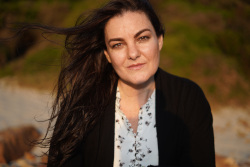
Carolina Ugaz-Moran, author, Aline and the Blue Bottle
When asked why she included Quechua she said, “I think the more exposed we are to languages as children, the more neurons we connect and the better we can develop the ability to become multilingual, so why not add Quechua and Spanish! But for me, it is more than learning a new language, it is about understanding a culture and exposing oneself to the abundance fountain of knowledge that each language provides.
Also, a few years ago, I found out that even though several people can speak Quechua (8-10 million people) very few people can actually read and write it due to the lack of printed material in Quechua. There have been efforts from the Peruvian, Ecuadorian, and Bolivian governments to introduce the language as an intercultural bilingual education; however, some indigenous people in each of these countries are having their children study in Spanish for the purpose of social and economical advancement. I thought I tried to help out a little plus I can learn on the way. Fun fact: there are about 45 varieties of Quechua which are all classified as separate languages and in addition, there are several dialects.”
When asked if her biochemistry studies help her or play a role in the project she said, “Yes, as well as my love for science and nature. This can be seen in several places. The chimera twins. They are powerful sylph sisters who have an important role in the book series. A chimera is a single organism that contains two sets of DNA with the code to make two separate organism. Simply put, it is an organism made up of cells from two or more different individuals.
The explanation of magic and how it flows, it somewhat reflects the states of energy as well as the law of conservation of energy. The blue and red stars and how from earth, the cooler stars appear red, and the high temperature stars appear blue. The symbiotic relationship between sharks and remora fish, I am an animal lover and I am looking for ways for people to admire and be kind to even the scariest of animals.”
She is working on the second book in the Aline series. It will be called Aline and the Kron Queen.

Click to buy Aline and the Blue Bottle
Comments:
Filed Under: Books
Posted by Elena del Valle on April 13, 2020
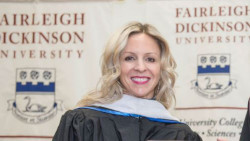
Krista Jenkins, Ph.D., professor, Politics and Government, Fairleigh Dickinson University
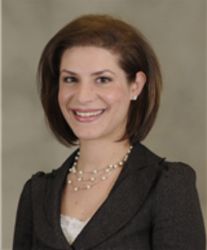
Julie Kalabalik-Hoganson, PharmD, director, Pharmacy Practice, Fairleigh Dickinson University
Photos: Krista Jenkins, Julie Kalabalik-Hoganson
A podcast interview with Krista Jenkins, Ph.D., professor of Politics and Government, and Julie Kalabalik-Hoganson, PharmD, director, Pharmacy Practice, Fairleigh Dickinson University, about pharmacists in COVID-19 front lines is available in the Podcast Section of Hispanic Marketing and Public Relations, HispanicMPR.com.
Julie is associate professor of Pharmacy Practice at Fairleigh Dickinson University School of Pharmacy and Health Sciences. She coordinates and teaches several courses in the Doctorate of Pharmacy program. She is a registered pharmacist in New Jersey and is dual board certified in pharmacotherapy and critical care.
Krista is the director of FDU’s survey research center, The FDU Poll. She is the author or co-author of A New Engagement? Political Participation, Civic Life and the Changing American Citizen, Mothers, Daughters, and Political Socialization, and Where Have All the Heroes Gone?
To listen to the interview, scroll down and click on the play button below or locate the “Podcast” section on the right hand side, then choose “HMPR Krista Jenkins, Ph.D., Julie Kalabalik-Hoganson, PharmD” or download the MP3 file to your iPod or MP3 player to listen on the go, in your car or at home from the RSS feed. Some software will not allow flash, which may be necessary for the podcast player. If that is your case, you will need to download the file to play it. To download it, click on the arrow of the recording you wish to copy and save it to disk. The podcast will remain listed in the April 2020 section of the podcast archive.
Posted by Elena del Valle on April 6, 2020
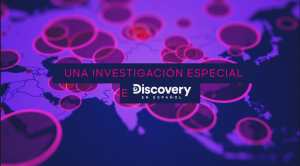
Video: Discovery en Español
Looking for more information on the COVID-19 pandemic in Spanish? At 9 p.m. E/P Wednesday April 8, 2020 Discovery en Español will air COVID-19: Pandemia 2020, a 43-minute special. The original program was in English. The Discovery en Español version will be in Spanish. Scroll down to watch a video clip in Spanish.
The special features suspenseful background music, news clips, domestic and international archive footage and on camera interviews with a handful of individuals from Mercatus Center at George Mason University, University College London, Council on Foreign Relations, The New York Times, and University Wisconsin-Madison.
The special outlines the general way the disease spread throughout China and other countries around the world in months, prompting a widespread quarantine in China, quickly mimicked by other countries.
It explains that the Center for Disease Control and Prevention (CDC) refused to adopt the COVID-19 test offered by the World Health Organization (W.H.O.), insisting on developing its own. This caused grave delays as the initial tests were faulty. According to one expert interviewed on the program flattening the curve efforts will result in the same number of people being stricken by the virus. It will take longer than without the social isolation measures.
The program was produced by ITN Productions for the Science Channel. The executive producers for ITN Productions are Ian Russell and Sarah Jane Cohen; Nick Powell is the producer. The executive producer for Discovery and Science Channel is Gretchen Eisele. The special will repeat on Sunday, April 12 at 10 p.m. and will also be available in the Discovery en Español Go app.

























